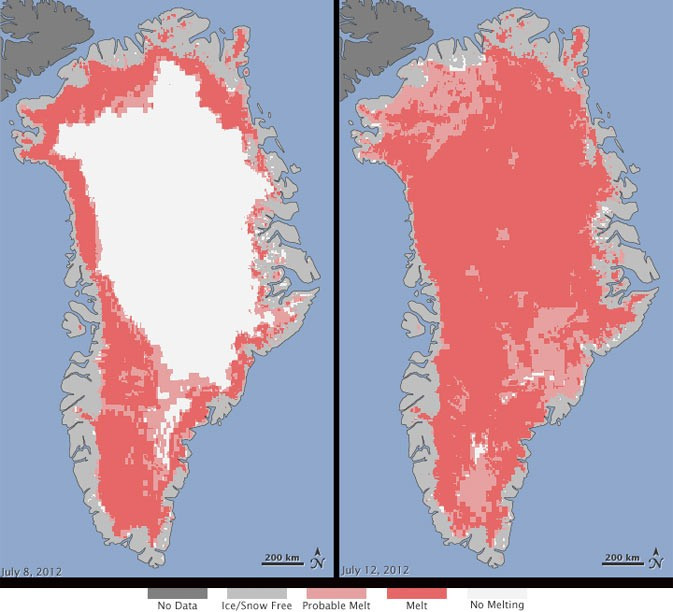Greenland Ice Sheet Melts at Alarming Pace

The ice in Greenland is melting at an alarming pace and a team of scientists has found that 97 percent of the ice sheet surface has melted in July alone. Almost all the ice in the country has experienced some degree of melting at its surface, according to a Nasa report, which came to the conclusion after analysing data from three satellites.
While analysing data from the Indian Space Research Organisation (ISRO) Oceansat-2 satellite, scientists were stunned to notice that most of the ice had completely disappeared on 12 July, 2012. "This was so extraordinary that at first I questioned the result: was this real or was it due to a data error," said Son Nghiem, scientist at the Nasa's Jet Propulsion Laboratory.
To confirm the rapid ice melt, scientists studied the surface temperature in Greenland using the Moderate-resolution Imaging Spectroradiometer (MODIS) on Nasa's Terra and Aqua satellites. The data showed that extremely high temperatures had indeed melted most of the ice in Greenland within a month.
Confirmation also came from University of Georgia scientists who analysed data from the Special Sensor Microwave Imager/Sounder on a US Air Force meteorological satellite.
Melt figures obtained from the three satellites showed that on 8 July, 2012 nearly 40 percent of the ice sheet's surface had melted and by 12 July 97 percent ice had vanished.
Scientists believe that the extreme ice melts could have occurred due to an unusually strong ridge of warm air or a heat dome over Greenland. The ridge was one of a series that has dominated Greenland's weather since the end of May.
"Each successive ridge has been stronger than the previous one," said Thomas Mote, a climatologist at the University of Georgia. This latest heat dome started to move over Greenland on 8 July, and then parked itself over the ice sheet about three days later. By 16 July, it had begun to dissipate."
Every year, nearly half of the surface of Greenland's ice sheet naturally melts and at high elevations, most of the melted water quickly refreezes in the place, but this year ice has rapidly melted within just a month. Scientists have not yet determined whether this extensive melt event will affect the overall volume of ice loss this summer and contribute to sea level rise.
"The Greenland ice sheet is a vast area with a varied history of change. This event, combined with other natural but uncommon phenomena, such as the large calving event last week on Petermann Glacier, are part of a complex story," said Tom Wagner, programme manager at Nasa. "Satellite observations are helping us understand how events like these may relate to one another as well as to the broader climate system," he said.
According to the scientists, such rapid ice melting events occur about once in every 150 years. In 1889, melting occurred and after nearly 150 years this event has occured again.
"Ice cores from Summit show that melting events of this type occur about once every 150 years on average. With the last one happening in 1889, this event is right on time," said Lora Koenig, glaciologist at the Nasa's Goddard Space Flight Center, in a statement.
© Copyright IBTimes 2025. All rights reserved.





















